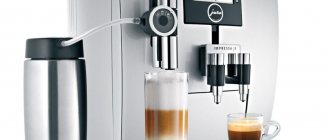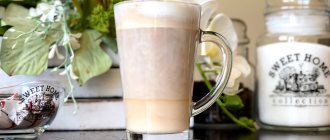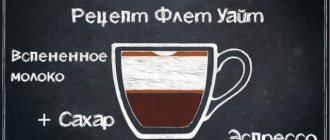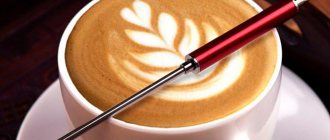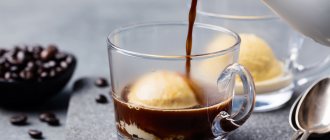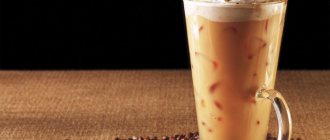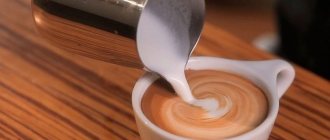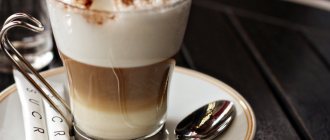If you ask for a latte in an Italian restaurant, the waiter will bring you a glass of milk (latte means “milk” in Italian). Coffee with milk, which in the rest of the world is shortened to simply “latte” (with the obligatory emphasis on the first syllable), is called café latte in Italian and nothing else.
Difference. The latte coffee drink is a mixture of coffee and milk with foam. When preparing a classic latte, milk is poured into the coffee. If you pour coffee into milk, you get a latte macchiato. Latte differs from its closest relative, cappuccino, in the proportions of ingredients (a much larger amount of milk) and relatively low milk foam.
History of the conquest of the world
Without exaggeration, let's call latte a “conqueror”, in the best sense of this brutal word. There are not many drinks on Earth that, having originated in one country, captivated the rest of the world with their merits. A simple mixture of coffee and milk created the most popular drink!
Americans claim the laurels of discoverers, claiming that in the middle of the last century the latte was invented by a certain bartender from California. And yet, the all-powerful inhabitants of the New World are unable to deny the Italian roots of the bartender - an emigrant from Europe. The mark of the Apennine peninsula boot remains forever on the name of latte.
In this case, justice triumphs; all over the world, latte is considered an Italian invention. The first tasters of the drink were children of Italian families, for whom their mothers, who had no idea that they were opening a new brand, diluted natural coffee with milk. They did this with the best intentions, wanting to protect their kids from the stimulating dose of caffeine and not separate them from the morning family meal.
Gradually, the recipe for latte (which means “milk” in Italian) moved from homes to coffee shops. The first to write about the new trend in Italian culinary fashion were the ubiquitous English reporters in the mid-19th century. Just at this time, a huge interest in antiquity arose in Europe and America and thousands of tourists went to admire Italian antiquities. Taking a break from exploring the works of art, they enjoyed a delicious coffee cocktail and its airy foam.
The latte reached its peak of popularity towards the end of the twentieth century and has not lost ground since then; the drink is one of the most beloved among people of all ages, genders, interests, views, affiliations and nationalities.
A coffee drink with an inimitable taste
The worldview that latte is an ordinary coffee with milk is incorrect. Essentially, this is a dessert with a pleasant smell, an unusual soft taste with a slight bitterness, making it more pronounced. When making it, you need to correctly correlate the proportions of the goods.
The traditional recipe includes the following ingredients:
- freshly ground coffee beans for making espresso;
- untainted drinking water;
- milk;
- sugar.
Italians pour espresso into heated milk, previously whipped into foam. Coffee is poured along the wall of the glass so that the milk foam is at the top. The resulting ratio is 1:2:1. A layered three-layer drink can be easily prepared in a coffee machine or Turk.
You can create a beautiful pattern into the milk foam using toothpicks. To create an unusual design, use the latte art technique. Fantasy is not limited, different patterns are used.
The dessert is prepared according to Italian, Irish, British and other recipes. The options are similar, but the ingredients and proportions are different.
The drink is served in a special glass Irish glass on a napkin. Some people prefer sweets. The dessert is decorated with the freshest berries: blueberries, raspberries, blackberries. You can add whipped cream on top of the milk. The calorie content increases, but the dish becomes very appetizing.
From history to linguistics
Perhaps because France is geographically closer to Russia or due to the fact that French was once the second native language for the Russian aristocracy, the name of a fashionable drink from Europe was pronounced with an emphasis on the last syllable. But you shouldn’t offend child-loving Italian mothers and skilled Italian baristas. In the word milk - latte, they emphasize the first vowel.
Important: competent speech is always in trend, so don’t forget that it’s correct to say latte. Even if you don’t have a trip to Italy in the near future, let’s not forget about it!
And this is a poem to reinforce:
What is more valuable to us than gold?
This is a smooth latte!
Orthoepic norms
The peculiarities of stress placement are studied by orthoepy. This branch of linguistics studies the features of the pronunciation of words in a particular language. One of the features of stress in modern Russian is its ability to move in a word from one syllable to another. Therefore, the pronunciation of some words may cause some difficulties.
You may be interested in: The concept of calories: converting kilocalories to joules
Also, another feature of stress in the Russian language is that in words with the same root it can fall on another syllable. Therefore, it is easier with indeclinable words - in them the stress always falls on one syllable. All these features make orthoepic norms in the Russian language flexible. Correct placement of stress is one of the indicators of a person’s high level of literacy.
Classic latte
Remember the name. Now let's prepare a latte according to the classical canons of Italian art. To do this, you need a coffee machine with a cappuccino maker that produces rich espresso and quickly froths the milk. I foresee your disappointment. Don't have such a unit at home? No need, we’ll make do with household equipment. The main thing is that you have the desire, some ground coffee and a glass of fresh milk.
We will brew coffee in the coffee maker that is in your kitchen. A Turk, a French press, or even an ordinary mug, in which we simply pour boiling water over the ground grains, are perfect for this purpose. The issue with making coffee has been resolved. Step two is the dairy issue.
A mixer, blender or small milk frother will whip up milk wonderfully. These are devices for technical solution of the issue. By hand, milk is foamed with a piston in a French press or in a jar with a tightly closed lid. Pour milk into it and shake vigorously for two minutes, foam will definitely appear. A classic latte does not require dense and tight foam like its closest “relative” cappuccino. An airy, delicate, light cap will perfectly decorate a dessert drink.
Let's remember: we froth hot milk mechanically; for the manual method of frothing it does not need to be heated. Heat the frothed cold milk in the microwave on medium mode for 1 minute.
The ratio of ingredients is as follows: a serving of espresso is 50 ml, a serving of milk is 100-150 ml, plus or minus 10-20 ml is acceptable. Those. 1 part coffee, 2-3 parts milk. Both products are hot, at least 60-70C°. Some people find that espresso makes lattes too strong. This is the opinion of most Americans, so instead of rich coffee, they take their light version of “Americano” for lattes.
To be honest, I don't understand them. And not only is this where my views on life differ from my overseas neighbors, but this is already a digression from the topic. If they like weak coffee with less caffeine, let them enjoy it.
Difficulties with foreign words
There are many interesting recipes, each of which has its fans. For example, delicious and sweet iced coffee. There are usually no difficulties in pronouncing this word, but you can often see a spelling mistake. The name of this recipe is correctly written with one letter “c”, as it comes from the French “glace”, which translates to “frozen” or “ice”. The following words also deserve special attention:
- barista;
- cappuccino;
- tiramisu;
- Americano;
- espresso.
You might be interested in Equipment for making coffee on sand at home
Coffee sommelier and specialist in preparing various types of coffee - barista. This word cannot be declined; it is always masculine. Therefore, it is correct to say: “She is an excellent barista.”
The name of the much-loved coffee recipe “Americano” does not yet have a fixed rule, but linguists are inclined to believe that it is a masculine word.
It is often difficult to spell the name “cappuccino”. In the menus of restaurants and cafes you can often see common errors, or rather double consonants “p” or “ch”. It is necessary to remember that the spelling “cappuccino” is the only correct one.
Striped latte and more
Another option, no less favorite and even more impressive in serving, is latte macchiato. It will require the same ingredients in the same proportions, the only difference is the sequence of combining coffee with milk.
In a latte, we pour foamed milk with a firm hand into a tall glass, where fiery espresso is already waiting for it. The result of a stormy reunion is a cocktail of a pleasant light brown color with soft tints of coffee shades. A white cap filled with air bubbles rises to the top. The cocktail looks very appetizing. I want to quickly eat the fluffy foam and drink the creamy coffee contents.
To create a macchiato, let's change the order of combining the components: pour coffee into milk. Very carefully, in a thin stream, slowly pour espresso into the frothed milk, which has already been poured into a serving glass. If coffee is brewed in a Turkish coffee pot, it must first be strained. Only a small speck from the stream should remain on the foam cap. By the way, translated from Italian, macchiato means “stained.”
A magical action will take place in the glass: the milk will gradually settle to the bottom, a layer of coffee will form in the center, and snow-white foam will form on the top layer. We will decorate it with cocoa powder, cinnamon, grated chocolate or nuts. Beauty, and that's all!
Tip: the ground coffee from which you brewed the drink is perfect for decorating a white cap. If the ground grain is of high quality and fresh, then such decoration will not only decorate the cocktail, but will also add flavor. To “powder” the delicate foamy “face” you will need literally a pinch.
I propose to move forward - decorate the macchiato with a fourth layer. To do this, choose any syrup except citrus fruits (they will spoil the milk). Berry, caramel, vanilla, maple, chocolate, nut and others are perfect, but they must be of good quality.
Note: I really like the syrups, sauces, and toppings produced by the UK company DaVinci Gourmet (da Vinci Gourmet). They are not cheap, but tasty and economical. Don't experiment with alcoholic liqueurs, nothing good will come of it. Tested in practice!
The syrup is poured into the glass first. Milk and coffee will not disturb the bottom layer, it will remain bright and clean, because the density of this product is greater than the density of milk, and especially coffee. But it’s still better to pour food slowly and carefully.
Interesting: there is another latte option, not striped. This is a “black latte”, i.e. "black latte" The striped suits of its unscrupulous distributors may turn out to be striped. Many buyers have become victims of deception and suffered severe disappointment from dashed hopes. Under this name, a drink was actively sold supposedly “for weight loss.”
It has the right to exist and fans of ghetto latte (ghetto latte). Everything here is simple and without deception. A portion of espresso is poured into a large glass, and a portion of frothed milk is poured into the same bowl. Two glasses are served, and you choose in what proportions to mix the drinks. You can take a sip of coffee or milk first and then start combining them.
How to write on the menu
There are even fewer difficulties with writing a latte drink than with pronunciation. Its name is written with 2 consonants “t”. This is easy to understand, since when pronouncing this word we usually double the hard “t” sound.
Here, coffee with milk has more luck than iced glass, cappuccino, espresso or tiramisu. Mistakes are often made in the spelling of these taken words.
Correct pronunciation of borrowings is very important for any person; it is an indicator of culture and education. Now you understand which syllable to emphasize, and you will order a latte in cafes and restaurants correctly. We hope that this mysterious title has become clear and common to you.
Watch a short video on the topic.
Correct pronunciation of latte.
Coffee latte attracts with its extraordinary taste, unusual color, and pleasant smell. It is curious that most lovers of this coffee dessert pronounce its name differently. So where should the emphasis be placed and what type of word “latte”? To understand this issue, you need to find out about the origin of the drink.
Product selection
To make a latte, you need ground coffee and milk, but do not forget that coffee is brewed with water and the taste of the finished cocktail also depends on its quality.
Coffee
We buy Arabica coffee beans; mixtures of its varieties and mixes with the addition of Robusta are suitable. It would be a good idea to grind the grains before cooking. The store will also grind the product, but then do not take a lot of ground coffee at once so that the aroma does not dry out. The grinding should be fine, but not to the point of dust or powder. The powder does not retain the beneficial qualities of natural grain. Give preference to dark (French or Italian) roasting.
Not too much attention is paid to the quality of coffee for a classic latte; the taste of this drink is dominated by soft milky notes. But for latte macchiato we choose higher quality coffee. In it, the layer of espresso has the right to an independent voice in the symphony of taste, and this sound is clearly distinguishable. Therefore, we take high-quality plantation Arabica beans, sparing no expense for pleasure.
Milk
The main question is: what fat content does the product need? Whichever one you want! If you count calories and take care of your figure, choose a low-fat product. If you prefer fattier and thicker milk, buy milk up to 6%; it’s a good idea to add cream to it for the unearthly pleasure of divine foam. Milk of any fat content will froth; the foam is formed not from fat, but from the protein contained in it.
Water
Don't risk undermining coffee's credibility. Even the best plantation single variety can be spoiled by hard chlorinated water. Take water from a filter jug, or better yet, buy bottled water. Spring and well water will do, but it’s a bit far to go. The mineralization of water intended for making espresso should be within 150 mg/l.
Composition and calorie content
Espresso is prepared with the addition of various ingredients, such as syrup and sugar. This increases the level of calorie and fat content.
A standard size cup of milk coffee (100 ml) contains about 50 kcal. People watching their weight should not use a fatty dairy product such as cream when cooking, as this will increase the calorie content of the drink. At the same time, for example, a latte with skim milk is not often offered in coffee shops, but it is easy to prepare at home.
To improve the taste of this drink, it is recommended to use spices, such as cinnamon stick. This component will give it not only a unique taste, but also a pleasant aroma.
Please note that the calorie content of a latte without sugar is much lower. The grains themselves contain virtually no carbohydrates. But adding sweeteners increases the level of energy value. By the way, this is a puff drink that is prepared proportionally.
Compound:
- 1 part strong espresso;
- 2 or 3 parts frothed milk;
- 1 part foam.
Violation of these proportions negatively affects the taste and aroma of coffee.
Let's serve the latte beautifully
The rules of etiquette stipulate that latte should be served in a tall transparent glass with a volume of 250-300 ml. There will certainly be a spoon next to it on the plate, with which the foamy cap is eaten. But such a scenario is not at all necessary. By mixing the foam with the contents of the glass, you will get a drink with a delicate texture that is drunk with special pleasure.
Latte macchiato in coffee shops is often served in Irish cream glasses. They have a beautiful shape and a comfortable handle at the bottom. A cocktail straw is placed on the saucer along with the layered drink. Some gourmets ignore its presence because they consider it blasphemous to add the taste of plastic to the taste of a luxurious latte. But those who want to try every layer of macchiato use a straw quite willingly.
On the basis of latte, a real art of decorating it was formed, which is called latte art. The skillful hands of the barista pour whipped milk foam from the spout of the pitcher jug in a special way, drawing unusual foam patterns.
Interesting: this type of designer latte art has its own “Olympic Games”. Since 2014, international latte art competitions have been held annually in the United States.
Differences between latte and cappuccino
In the modern world, it is difficult to find a person who has never tried a latte or cappuccino in his entire life. However, not everyone knows the difference between them. Also, many people make a mistake in the word “cappuccino”, believing that it contains double letters. At the same time, in the word “latte” the stress always remains on the first syllable.
The main difference between a cappuccino and a latte is, first of all, that the latter is not coffee. In fact, a latte is just a coffee drink; sometimes it is also called a cocktail. It may follow from this that the volume of coffee in a cappuccino is much larger than the entire drink. If you rely on the classic latte recipe that we described above, two servings of milk are required per serving of espresso (milk foam can also be used). For cappuccino, each ingredient has the same proportions.
Proportions of milk and espresso in cappuccino and latte.
Even their foams are different. Of course, milk foam in any case should have a uniform consistency and no air bubbles. But the significant difference is that thicker foam is used for cappuccino. When the foam does not fall off when sugar gets on it, this means that the drink is prepared correctly.
However, both drinks still have similarities. Namely, the method of their preparation. First, a portion of coffee is poured, then milk is added. It must first be heated to a certain temperature. Usually it is about sixty degrees.
The serving method also differs for each type of coffee. For cappuccino, cups of 180 milliliters are usually used, no more. With this volume you get a better balance between milk and espresso. To ensure that there is enough milk for the entire coffee, it is better to use cups with an expanded top.
For both latte and cappuccino, the same temperature is acceptable, no higher than seventy degrees. By adding frothed milk to the drink, you can use it to create various patterns on the surface. There is a special technique called latte art.
In conclusion, we can conclude that the similarities between the two types are only in the method of preparation. Everything else is completely different.
(2 likes)
Ukrainian Coffee Festival
Previous post
Americano
Next entry
Briefly about what was said
There are no secrets about lattes anymore. It remains to concentrate the information:
| Latte | Latte macchiato | |
| How much coffee is required in ml | 50 | 50 can double espresso |
| How much milk is required in ml | 100 — 150 | 100 — 150 |
| Requirements for milk froth | light, airy | dense, dense |
| How to pour | frothed milk poured into coffee | coffee is poured into frothed milk in a thin stream |
| What kind of dishes? | tall transparent glass, Irish glass with a volume of 200-250 ml, can be poured into a ceramic cup with a volume of 150-200 ml | tall transparent glass, Irish glass with a volume of 200-250 ml |
| Availability of layers | no, just a cap of foam | yes, plus a cap of foam |
| Serving | The glass is placed on a saucer, a spoon lies next to it | the glass is placed on a saucer, next to it is a spoon and a straw |
| Supply temperature | hot, not higher than 70C° | when hot, not higher than 70C° |
I have no doubt that you have already tried making a latte. How difficult was this process? Which products did you prefer? How did you decorate the white cap? Be sure to tell us!
How to serve the drink?
You can use any utensils that meet several requirements. It needs to have transparent walls and be quite heat resistant.
Not the last element in serving this type of coffee is aesthetics. If made correctly, you will get a drink from several correctly broken layers. And this should be seen by the person who will try.
In establishments, it is customary to serve latte coffee in Irish glasses. They look like this:

